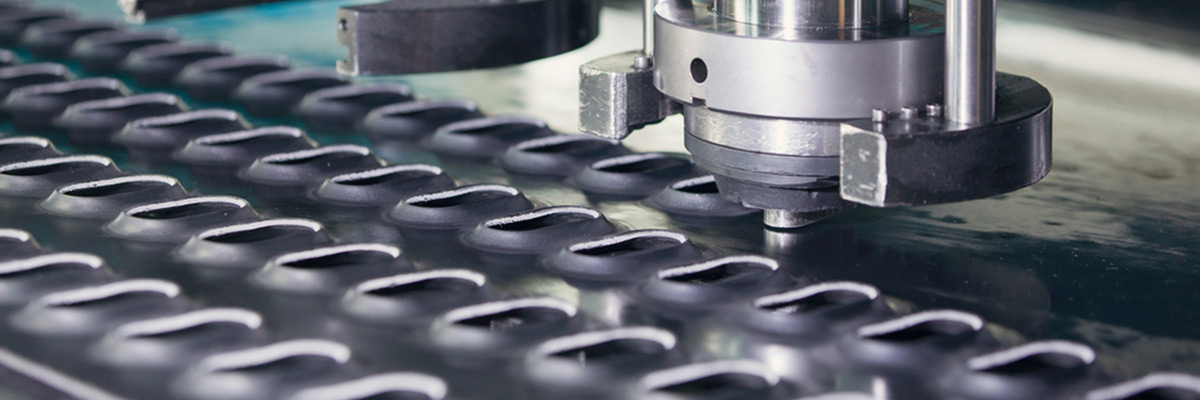The Difference Between Steel Punching & Steel Cutting
return to Blog

Working with steel fabrication means understanding which method will deliver the results you want. Two of the most common methods are steel punching and steel cutting. Our expertise means we can easily decide which method to use, but we understand that you need to know why we make that decision. Here’s a simple guide to the differences between steel punching and steel cutting, including the advantages and disadvantages.
Metal fabrication has come a long way in recent years and there are new technologies and methods for cutting steel to create precise shapes for a wide range of industries and applications.
Using computer guidance, machinery can fabricate steel into precise shapes which reduces errors, unnecessary waste and drives down expenses so that customers can get exactly what they are looking for at cost-effective prices.
There are different methods used in this fabrication process, including steel punching and cutting. They all have their own advantages and applications to ensure that you have a high-quality finish. But what are the differences between them?
The different methods of steel cutting
There are three main ways that you can cut steel in a fabrication workshop including laser cutting, plasma cutting and water jetting. Each method is used for different purposes, including:
-
Laser cutting: This is the most common method and it is a cost-effective way to precisely cut metal into the desired shapes. The large difference between laser cutting and traditional, outdated forms of metal fabrication is that the laser never actually touches the metal. A high-powered laser is controlled by a computer software program that guides the laser over the material and cuts it with extreme precision.
It is highly effective on all types of steel (and various thicknesses), with the precision of the laser and the accuracy of the computer guidance allowing for more complex shapes and designs that are finished to your exact specifications.
-
Plasma cutting: While plasma cutting is not as precise as laser cutting, it is highly effective. Plasma is jetted through the steel using air or gas at high speed, allowing for the rapid mass production of fabricated steel components. This method is best used when basic designs are required in large quantities, as plasma cutting can produce high volumes quickly for greater cost efficiencies.
- Water jetting: As the name suggests, this involves an extremely high-speed stream of water being used to cut the steel. The result is a clean cut that will not require machining afterwards because there are no burning or jagged edges. While water jetting can be used on steel, it is not as accurate as laser cutting. This method is primarily used on stone and exotic metals like bronze and tungsten.
How is metal punching different to metal cutting?
While the methods of metal cutting we described can be used to cut metal into various shapes and designs, metal punching is the process of cutting holes or other cut-outs into the metal itself.
A punch press is used to create geometric shapes in the metal that can be simple, like squares and circles, or more complex in design. The steel sheet moves along a conveyor and is pressed between the punch press located above and the mould in the shape of the feature to be cut out of the material.
This process is carried out using computer numerical control (CNC) software for the highest levels of accuracy, although machining will often be required to smooth out the edges. Most forms of steel along with copper and aluminium can be used in the metal punching process.
Often metal cutting and metal punching are both required to complete an overall project, so it is always best to have this fabrication done in the same workshop by a reputable fabrication company.
Top End Steel Supplies has the latest CNC and laser cutting innovations to take care of your cutting and steel punching requirements in the Northern Territory. For more information on our services, call us on (08) 8931 0055 or email us at sales@topendsteel.com.au.
Steel Punching Is Powerful
The punch press dates back to the 60s when it was first used as a manual method of dividing steel. The tech has developed, but the principle remains the same. Steel punching works by forcing a steel sheet through a punch and die.
This can be done by using the hands or by Computer Numerical Control (CNC). CNC is a little more accurate because numerical control reduces the incidence of human error.
What Can A Punch Press Make?
A punch press is great for flaps and forced-out holes for things like mechanical attachments. We also use them for stamping on piece identifiers and symbols.
Benefits Of Steel Punching
- Fast option for projects where a lot of holes need to be made
- Cheaper to run than laser cutting
- Low energy usage compared with other methods
- All in one solution – punching and forming happen on a solitary piece of equipment.
- Steel punch tech can be applied to additional operations
Drawbacks To Steel Punching
- High machine turnover – the punch wears over time, and tool heads degrade with each use
- Consistency can be compromised as tools are eroded
- Lack of flexibility – tools are best used to create simple, geometric designs
- More waste than other methods
- Significant time to assemble
- Limited to working with a maximum 0.8 cm thickness
- Can be costly
- Noise levels can pose a risk to health
Steel Cutting
The most commonly used type of steel cutting is laser cutting. It’s known to be highly accurate and very fast. Laser cutting works by using laser beams to make the cut, followed by a flow of gaseous air to create the desired form. It’s versatile and effective.
What Is Steel Cutting Used For
Steel cutting with lasers is most appreciated when working with intricate designs that need a high level of precision. Lasers produce very small kerf and work with CNC tech to maximise accuracy and minimise wastage.
Benefits Of Steel Cutting
- Steel cutting is versatile – an almost infinite variety of forms can be created
- Steel cutting with lasers can be used for sheets up to 25mm thick
- Cutting can be used to create curves, intricate patterns and detailed touches
- Incidence of indentation from tools is reduced
- Machines are low maintenance
- Reduced heat affected zone (HAV) means low distortion
- Versatility – laser cutting can produce almost any shape, and can be used for metal sheets as thick as 25 mm
- Speedy assembly time
- High work rates – 10,000 impacts for every minute as opposed to punching (1000 impacts for every minute)
Disadvantages Of Steel Cutting
- Forming parts is a separate operation, so additional set-up is needed
- Operating costs are a little higher
Other Methods Of Steel Cutting
There are various other ways to cut steel such as plasma cutting, water jet cutting and flame cutting. These are used for tasks with specific requirements, for example, plasma cutting offers a way to cut very thick sheets, and water jet cutting is ideal for situations where heat needs to be minimised.
Get In Touch
The good news is that you don’t have to decide which method of fabrication is best for your project.
At Top End Steel Supplies we’ve been working with steel for over 15 years. We’ll take every aspect of your project into account and offer the best solution to give you a result that works.
To find out more just get in touch online or give us a call on 08 8931 0055.
